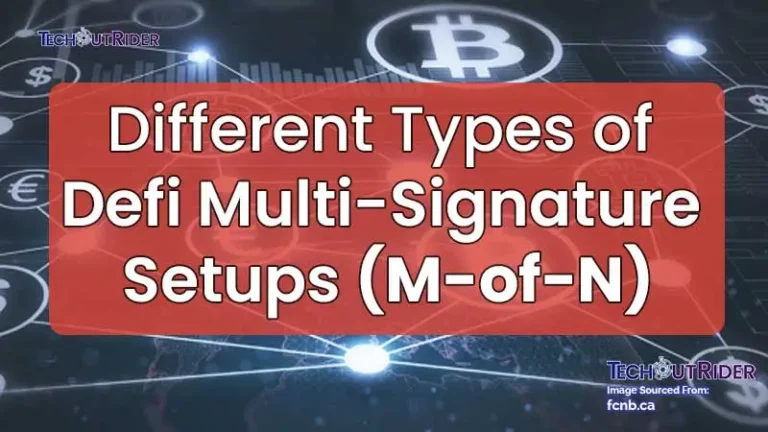In the ever-evolving landscape of blockchain technology, security remains a paramount concern.
As the popularity of cryptocurrencies continues to soar, ensuring the safety of digital assets becomes a top priority.
One innovative solution that has gained prominence is the implementation of multi-signature setups, particularly M-of-N schemes.
In this blog post, we will delve into the intricacies of different types of multi-signature setups, shedding light on their significance and applications.
What are Multi-Signature (Multisig) Setups?
Multi-signature, or multisig, refers to a cryptographic technique that requires multiple private keys to authorize a transaction.
This method introduces an extra layer of security compared to traditional single-signature transactions.
The most common multisig setup is denoted as M-of-N, where M represents the minimum number of required signatures, and N is the total number of possible signatories.
Types of Multi-Signature Setups
- 2-of-2 (2-of-2):
- In this basic configuration, two private keys are required out of a total of two. Both keys must sign a transaction for it to be valid. While simple, this setup can be useful for joint accounts or partnerships where unanimous consent is necessary.
- 2-of-3 (2-of-3):
- This setup requires two out of three possible private keys to authorize a transaction. It enhances security by allowing for the recovery of funds if one key is lost or compromised. This is commonly employed in scenarios where a user wants to have a backup key for account recovery purposes.
- 3-of-5 (3-of-5):
- In more complex scenarios, a 3-of-5 configuration requires three signatures out of a possible five. This offers increased flexibility and security for organizations or groups, ensuring that a predefined majority must agree on a transaction.
- N-of-M (N-of-M):
- Generalizing the concept, N-of-M allows for a customizable approach where any N number of private keys out of M can authorize a transaction. This flexibility is particularly useful in diverse organizational structures or scenarios where consensus may vary.
Application and Uses of Multi-Signature Setups
- Secure Wallets:
- Cryptocurrency wallets with multi-signature capabilities provide users with an added layer of protection against unauthorized access. Businesses and individuals can implement multisig wallets to safeguard their digital assets.
- Smart Contracts:
- Multi-signature setups are integral to the functionality of smart contracts. They ensure that predefined conditions are met before a contract is executed, minimizing the risk of fraudulent or erroneous transactions.
- Escrow Services:
- Platforms offering escrow services leverage multi-signature setups to facilitate secure transactions. The involvement of multiple parties in the authorization process adds an extra layer of trust for all parties involved.
- Corporate Governance:
- Businesses and organizations can utilize multi-signature setups for corporate governance, requiring multiple executives or board members to authorize critical transactions or decisions.
Conclusion
As the cryptocurrency and blockchain landscape matures, the importance of robust security measures cannot be overstated.
Multi-signature setups, particularly M-of-N schemes, provide an effective solution to enhance the security of digital assets and transactions.
Whether applied to wallets, smart contracts, or corporate governance, the versatility of multi-signature configurations ensures a customizable approach to meet the evolving needs of the blockchain ecosystem.
Embracing these advanced cryptographic techniques is a crucial step toward a more secure and resilient digital future.
FAQs – Frequently Asked Questions
Q1. What is a multi-signature (multisig) setup?
Answer: Multisig is a cryptographic method requiring multiple private keys for transaction authorization, enhancing security.
Q2. What does M-of-N signify in multi-signature setups?
Answer: M-of-N denotes the minimum number of required signatures out of a total number of possible signatories.
Q3. How does a 2-of-2 multi-signature setup work?
Answer: In a 2-of-2 configuration, both private keys must sign a transaction for it to be valid.
Q4. Why is a 2-of-3 setup beneficial in cryptocurrency wallets?
Answer: 2-of-3 allows for account recovery if one key is lost or compromised, providing added security.
Q5. What is the significance of a 3-of-5 multi-signature configuration?
Answer: 3-of-5 adds flexibility and security, requiring a majority consensus for transaction authorization.
Q6. How can multi-signature setups be applied to smart contracts?
Answer: Multisig ensures predefined conditions are met before a smart contract is executed, reducing risks.
Q7. In what scenarios is an N-of-M multi-signature setup useful?
Answer: N-of-M offers a customizable approach, suitable for diverse organizational structures and consensus scenarios.
Q8. How do multi-signature wallets enhance security in cryptocurrency transactions?
Answer: Multi-signature wallets provide an extra layer of protection by requiring multiple key authorizations.
Q9. What role do multi-signature setups play in corporate governance?
Answer: Businesses use multisig for secure corporate governance, requiring multiple authorizations for critical transactions.








